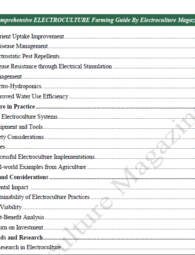Welcome to Electroculture Magazine, your trusted source for electrifying insights in the world of agriculture! In this enlightening blog post, we address an important question: “Electroculture for Beginners, Is it Easy or Not?” If you’ve ever been curious about delving into electroculture but hesitated due to perceived complexity, fear not! We are here to guide you through the process and demystify this innovative farming technique. Join us as we break down the fundamentals of electroculture in a beginner-friendly manner, providing step-by-step instructions, practical tips, and debunking common myths.
Discover the simplicity behind setting up electroculture systems, understanding electrical parameters, and integrating them into your farming practices. Empower yourself with the knowledge and confidence to embark on this electrifying journey towards sustainable and high-yielding agriculture. Let’s make electroculture accessible and achievable for beginners, inspiring a new generation of farmers!
Introduction
In this post “Electroculture for Beginners,” we will delve into the fundamental principles of electroculture, offering clear explanations and practical tips to get you started on your electroculture journey. From understanding the science behind this technique to exploring different equipment and implementation methods, we aim to equip you with the knowledge and confidence to incorporate electroculture into your own gardening practices.
As beginners in electroculture, remember to start small and gradually expand your knowledge and expertise. Experiment with different plants, electrode placements, and electrical parameters to find what works best for your specific gardening conditions. Keep a keen eye on plant response and adjust your approach accordingly.
Electroculture may seem like a complex gardening technique, but beginners can easily get started with a few simple steps. Here’s a breakdown of how you can begin your electroculture journey:
Selecting the Right Plants
Select organisms known to respond favorably to electroculture. Although many plants can benefit from electrical stimulation, some species exhibit more pronounced growth and yield enhancements. Tomatoes, peppers, cucumbers, lettuce, and various herbs are all examples of plants that respond positively to electroculture. Research the specific needs and suggestions for each plant you intend to cultivate.
Understanding Electrical Stimulation
Gain a basic understanding of how electrical stimulation influences plant growth. Electricity can stimulate root development, enhance nutrient absorption, and activate biochemical processes within the plant. It is essential to comprehend the optimal voltage, frequency, and duration of electrical application for different plants and growth stages. This information can be found through scientific studies, gardening resources, and experienced electroculture practitioners.
Tools and Equipment
Acquire the necessary tools and equipment for electroculture. As a beginner, start with a simple setup before progressing to more advanced systems. You will need:
- Power source: This can be a battery, solar panel, or electrical outlet, depending on the scale of your electroculture setup.
- Electrodes: Choose suitable electrodes based on the method you intend to use. Electrodes can be metal rods, plates, or wires.
- Wires and connectors: These are required to connect the power source and electrodes.
- Controller (optional): A controller allows you to regulate the electrical parameters and automate the electroculture process. However, it is not essential for beginners.
Ensure that you follow safety guidelines and use insulated wires, proper grounding, and waterproofing measures to prevent electrical hazards.
Implementing Electrodes
Decide on the electrode placement method based on the plant and your gardening setup. There are three common techniques for electrode placement in electroculture:
- Direct Electrodes: Place the electrodes directly in the soil around the plant’s root zone. This method is suitable for potted plants or garden beds.
- Indirect Electrodes: Install the electrodes near the plant but not directly in the soil. This approach is useful for larger plants or when you want to treat multiple plants with a single electrode setup.
- Soil Electrodes: Bury electrodes in the soil away from the plant’s root zone. This method stimulates the soil environment, benefiting multiple plants simultaneously.
Experiment with different electrode placements to determine the most effective method for your specific plants and gardening conditions.
Safety Precautions
Prioritize safety when working with electricity. Make sure to:
- Disconnect the power source before making any adjustments or handling the electrodes.
- Use insulated wires and connectors to minimize the risk of electric shocks.
- Avoid overexposure of plants to electrical stimulation. Start with shorter durations and gradually increase based on plant response and recommendations.
- Regularly inspect and maintain your equipment to ensure proper functionality and prevent accidents.
Remember, electroculture is an evolving field, and it’s important to stay updated with the latest research, techniques, and safety practices as you progress on your electroculture journey.
By following these steps and continuously learning and experimenting, beginners can successfully embark on their electroculture adventure and enjoy the benefits of enhanced plant growth and increased yields in their gardens.
Buy Our Handcrafted Electroculture eBook Now…
Final Words
Dear readers, congratulations on taking your first steps into the enthralling world of electroculture! This comprehensive guide explores the principles, techniques, and benefits of electroculture, equipping you with the knowledge and instruments necessary to begin your own electrifying gardening journey.
Electroculture is a novel approach to gardening that harnesses the power of electricity to enhance plant growth, boost yields, and encourage sustainable agricultural practices. By comprehending the science behind electroculture and employing the appropriate techniques, you can unleash the potential for healthier, more robust plants in your garden.
Happy gardening and may your plants thrive with the electrifying power of electroculture!
Get more accurate guidance from ELECTROCTURE TEXTBOOKS, choose your book by clicking below...

















![Electroculture Bible: [7 IN 1] by Rick Croppield Electroculture Bible: [7 IN 1] by Rick Croppield](https://electroculturemagazine.com/wp-content/uploads/2023/08/B0C47Q56RC.01._SCLZZZZZZZ_SX500_-200x290.jpg)

![Electroculture Bible: [5 IN 1]: by Benjamin Foster Electroculture Bible: [5 IN 1]: by Benjamin Foster](https://electroculturemagazine.com/wp-content/uploads/2023/08/51XVYHHWHfL._SX384_BO1204203200_-200x290.jpg)

